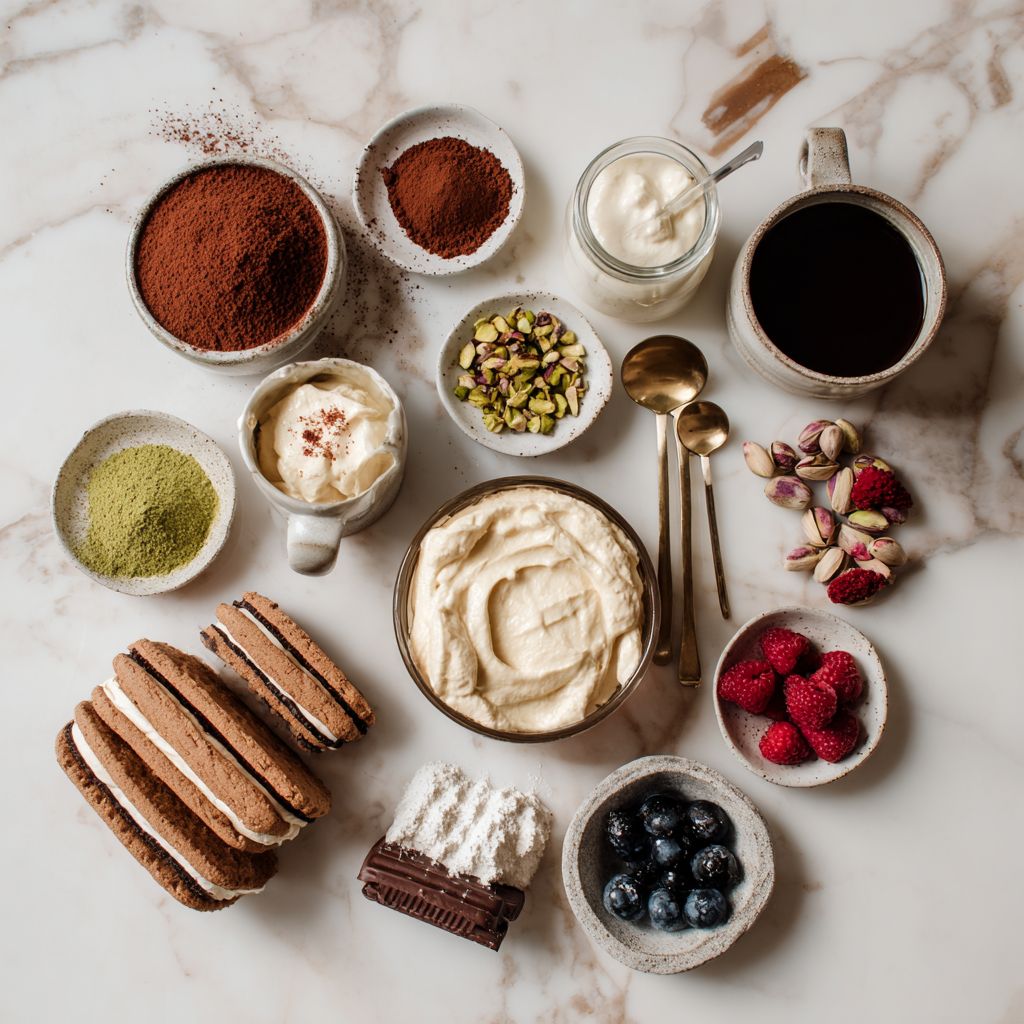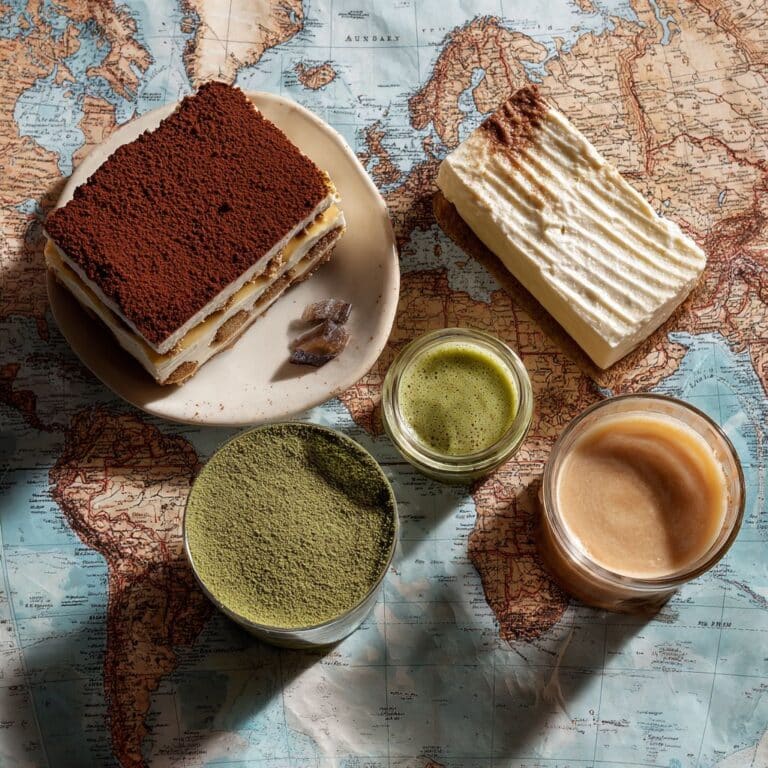
Table of Contents
ToggleA Dessert Loved Around the World
This layered Italian dessert has become a symbol of comfort, indulgence, and flavor. Its classic blend of espresso-soaked ladyfingers, velvety mascarpone, and cocoa powder creates a taste that’s beloved across the globe. But what exactly is it? Is it really from Italy? And how did it gain such international fame?
In this complete guide, we’ll explore its history, core ingredients, and how to make it the authentic way. Whether you’re new to this dessert or already obsessed, there’s always something new to learn—and taste—when it comes to the world’s most famous no-bake treat.
What Is Tiramisu and Where Did It Come From?
From Veneto to the World: An Italian Classic
The word “tiramisu” means “pick me up” in Italian—a perfect name for a dessert that lifts both mood and spirit. With its rich coffee flavor and creamy texture, this no-bake recipe has become a staple in restaurants and homes alike.
While the exact origin is debated, most agree it was born in Treviso, in northern Italy’s Veneto region, around the 1960s. The most well-known claim credits Le Beccherie, a family-run restaurant, with serving the first version of this dessert to tired workers and new mothers who needed a little comfort.
Originally, it was a humble dish. Simple, practical, and made with kitchen staples like eggs, sugar, leftover biscuits, and espresso. Over time, it made its way into cookbooks and café menus worldwide.
Want to start with the most authentic version? Try our classic tiramisu recipe—the dessert that inspired a thousand variations.
Meet James — Our Virtual Chef with a Passion for Tradition
This dessert isn’t just a recipe—it’s a story. And no one shares it better than James, our virtual chef at tiramisucake.com. Though he’s powered by artificial intelligence, his cooking philosophy is rooted in family kitchens, traditions, and the kind of instinct passed down through generations.
James has studied thousands of versions of this classic, from its rustic Italian roots to the modern variations seen in homes today. Whether you’re curious about plant-based versions like our vegan tiramisu or just want to know how to layer it properly, James will walk you through every detail.
In this guide, James helps answer some of the most common questions home bakers ask:
- What is it made of? From mascarpone and ladyfingers to cocoa and coffee—every layer counts.
- Is it really Italian, or has it become something global? We explore both tradition and innovation.
- Does it usually include alcohol? Learn about the classic method and easy non-alcoholic swaps.
- Can it be adapted to special diets? We show you how to make it gluten-free or dairy-free with ease.
James brings together tested instructions, cultural insights, and a passion for real flavor—making this guide your go-to reference for anything related to this iconic dessert.
Want a faster, beginner-friendly version? Check out our easy tiramisu recipe.
Ingredients That Make or Break a Great Tiramisu

Understanding the Essentials: What Goes into a Traditional Tiramisu
The magic of tiramisu lies in its simplicity. When made with care, just a few ingredients come together to create one of the most iconic desserts in the world. But to achieve that perfect balance of creaminess, coffee flavor, and just the right amount of sweetness, the ingredients you use—and how you use them—matter more than you think.
At its core, a traditional tiramisu recipe includes:
- Ladyfingers (Savoiardi) – dry, crisp Italian biscuits that soak up espresso like a sponge
- Espresso or strong coffee – unsweetened, bold, and full-bodied
- Mascarpone cheese – rich, smooth, and slightly tangy
- Egg yolks – for creaminess and structure
- Sugar – to balance the coffee’s intensity
- Cocoa powder – dusted on top for that signature finish
Some variations include whipped cream or egg whites to lighten the texture, but the classic method stays true to bold flavors and silky richness.
If you’re unsure about sourcing or storing ingredients like mascarpone or fresh eggs, visit the USDA Food Safety page for up-to-date handling tips.
Modern Adjustments: Dietary Needs and Flavor Innovations
Today, tiramisu has become more than a classic—it’s a dessert that adapts. Home cooks everywhere now tailor it to fit different dietary needs, allergies, and creative flavor profiles. And while these versions may differ from the original, they keep the spirit of tiramisu alive.
Dairy-Free and Gluten-Free Options
For those with sensitivities, there are great alternatives that don’t compromise texture or taste. Our gluten-free tiramisu uses gluten-free ladyfingers that hold their shape without turning soggy. You’ll also love the vegan tiramisu, made with plant-based cream and egg-free layers—perfect for those avoiding dairy or eggs.
Flavor Twists: From Citrus to Nutty
Tiramisu is also a great base for flavor experimentation. Looking for something light and zesty? Try the lemon tiramisu, which swaps coffee for a refreshing citrus syrup. Or if you’re after something more decadent, our pistachio tiramisu adds a creamy pistachio layer that pairs beautifully with the cocoa finish.
These variations prove that while tradition is important, creativity makes tiramisu truly timeless.
A Note on Taste Without Additives
Some believe this dessert needs extra flavor enhancers to shine—but with high-quality mascarpone, real espresso, and the right balance of sugar and bitterness, no additions are necessary. The original formula is simple, clean, and elegant.
If you’re serving children or guests with specific dietary needs, these adjusted versions ensure that everyone can enjoy a slice—without sacrificing what makes tiramisu special.
For safety tips on using raw ingredients and safe storage, consult the official USDA guidelines.
Key Takeaway
Tiramisu isn’t just about following a recipe—it’s about choosing the right elements and treating them with respect. Whether you stay classic or explore new versions, always start with quality ingredients, clear instructions, and a little patience. That’s how great tiramisu is made.
Coming up next, we’ll walk through how to make tiramisu step by step, from layering techniques to common mistakes—and how to fix them.
How to Make Authentic Tiramisu – Step by Step

The Method Behind the Magic: Step-by-Step Tiramisu at Home
You don’t need to be a pastry chef to make incredible tiramisu at home. With the right ingredients and a little attention to detail, this no-bake dessert comes together beautifully—even on your first try. The key lies in the balance between bold espresso, creamy mascarpone, and the soft bite of ladyfingers.
Let’s break it down, layer by layer.
1. Prepare Your Base and Cream Layers
Start by brewing a fresh cup of strong espresso and let it cool. If you don’t have an espresso machine, instant espresso powder works well—just make sure it’s bold. Pour the coffee into a wide bowl so it’s easy to dip the ladyfingers later.
While the coffee cools, prepare your mascarpone mixture. In a large mixing bowl, whisk together egg yolks and sugar until pale and thick. Then gently fold in the mascarpone until smooth and creamy. For a lighter texture, some people fold in whipped cream—but purists usually keep it simple.
Want a shortcut? Our tiramisu cups offer the same layers in single-serve glasses—perfect for parties or individual desserts.
2. The Art of Layering
Quickly dip each ladyfinger into the cooled espresso—just 1 to 2 seconds per side. Over-soaking will make them mushy, while under-soaking leaves them dry. Arrange the soaked ladyfingers in a single layer across the bottom of your dish.
Next, spread half of your mascarpone cream over the biscuits and smooth it out. Repeat with another layer of soaked ladyfingers and top it with the remaining cream. Cover and chill the dish for at least 6 hours, preferably overnight. This allows the flavors to meld and the texture to firm up.
Before serving, dust the top generously with unsweetened cocoa powder for that signature look.
3. Presentation Options: Cups, Cookies, and More
Classic tiramisu is often made in a square or rectangular dish, but it’s just as delicious in smaller formats. Try layering it into jars or glasses like we do in our tiramisu cookies for portable treats. For something creative and seasonal, our pumpkin tiramisu adds a warm, spiced layer of fall flavor.
And if you’re in the mood for a rich twist, don’t miss our tiramisu brownies—a fudgy, coffee-kissed treat that blends two classic desserts into one unforgettable bite.
4. Mistakes to Avoid: Common Tiramisu Pitfalls
Even though it’s a relatively simple dessert, tiramisu can go wrong if you rush the process. Here are some of the most common mistakes—and how to avoid them:
- Over-soaking the ladyfingers – They’ll fall apart. One quick dip is enough.
- Using watery mascarpone – Always drain if necessary and keep it chilled before mixing.
- Skipping chill time – This step is essential for texture. Let it rest at least 6 hours, overnight is ideal.
- Uneven layering – For a professional look, use a piping bag or offset spatula to smooth the layers.
Remember, great tiramisu is about patience. It’s a dessert you prepare ahead, not at the last minute. But the reward is worth every step.
5. Storage and Serving Tips
Once assembled, tiramisu should be kept in the fridge and consumed within 2 to 3 days for optimal texture and taste. Don’t freeze it—it will separate. Serve chilled straight from the fridge, with an extra sprinkle of cocoa or grated dark chocolate on top just before serving.
Individual cups are perfect for events, while larger dishes are great for family dinners. For gifting or bake sales, mini cookie versions are a hit.
Explore Modern Tiramisu Variations

From East to West: Flavor Innovations Worth Trying
Desserts evolve, and this one is no exception. Around the world, home bakers and pastry chefs have started adding bold, surprising flavors to a beloved classic. These fresh takes keep the core elements while introducing exciting new ingredients and cultural twists.
For example, our matcha tiramisu swaps espresso for vibrant green tea, creating a delicate balance between earthiness and creaminess. It’s perfect for those who love desserts that aren’t overly sweet, and it brings a modern elegance to any table.
Fruity versions are just as popular. Our strawberry tiramisu replaces coffee with berry syrup and real fruit slices. The result? A refreshing treat ideal for warmer seasons. The creaminess stays, but the flavor profile is lighter, brighter, and just as satisfying.
These creative variations prove that a dessert rooted in tradition can also be playful and diverse—without losing its identity.
Dessert Crossovers: Combining Layers and Creativity
Sometimes, blending two dessert worlds creates something unforgettable. That’s exactly what happens in our tiramisu cheesecake. With a biscuit base soaked in rich coffee and a creamy top made of mascarpone and cream cheese, it’s both familiar and completely new.
Another fan favorite is the biscoff tiramisu, which replaces ladyfingers with spiced cookies. The caramel flavor of Biscoff adds warmth and crunch, making each bite a little more indulgent.
These hybrids are more than gimmicks—they’re thoughtful reinterpretations. Each one respects the layering method, texture, and presentation that make this dessert so iconic, while adding something fun and unexpected.
Whether you’re baking for a party or just want to try something new, there’s a version for every occasion.
Want to Explore More?
This is only a small taste of what’s possible. Our full recipe collection includes classics and contemporary favorites for every palate and need:
- Classic tiramisu recipe – the foundation
- Easy tiramisu recipe – for quick prep
- Vegan tiramisu – dairy- and egg-free
- Pumpkin tiramisu – perfect for fall
- Tiramisu cups – elegant, portioned servings
No matter your flavor preference or dietary need, there’s always a new version to enjoy.

Frequently Asked Questions About Tiramisu
1. What is tiramisu?
Tiramisu is a layered Italian dessert made with ladyfinger cookies soaked in strong coffee, layered with a rich mascarpone cream, and finished with a dusting of cocoa powder. It’s known for its velvety texture and balanced contrast of bitter, creamy, and sweet notes. Originally from Italy, it has gained popularity around the world for its elegant yet comforting appeal. The word itself means “pick me up,” which reflects both the caffeine content and its mood-lifting nature.
2. How to make tiramisu?
To make tiramisu at home, start by brewing a strong cup of coffee and letting it cool. Dip ladyfingers quickly into the coffee and layer them in a dish. Prepare the cream by whisking together egg yolks, sugar, and mascarpone cheese until smooth. Spread half of the cream over the first cookie layer, then repeat with another layer of soaked cookies and the remaining cream. Chill for at least 6 hours. Before serving, dust with cocoa powder. The process is simple but requires patience and precision for best results.
3. What does tiramisu taste like?
Tiramisu has a distinct flavor that combines bold coffee, smooth mascarpone cream, and bittersweet cocoa. The soaked ladyfingers give it a spongy texture that contrasts beautifully with the silky layers of cream. It’s not overly sweet—just enough to satisfy a dessert craving without being heavy. The combination of coffee and cocoa adds depth, while the mascarpone provides a light, tangy richness that balances the overall flavor.
4. Can you freeze tiramisu?
Yes, tiramisu can be frozen, although the texture may change slightly when thawed. To freeze, wrap the dish tightly in plastic wrap and then foil. It’s best consumed within one month. When ready to serve, let it thaw in the refrigerator overnight. Note that mascarpone may lose some of its original creaminess during freezing, so while freezing is convenient, fresh is usually preferred for the best experience. Single portions tend to freeze better than large pans.
5. Is tiramisu Italian?
Yes, tiramisu is originally from Italy. Most sources agree it was first created in the Veneto region during the 1960s or 1970s, although the exact origin is still debated. Over time, it has become one of the most famous Italian desserts worldwide. Despite modern variations and local adaptations, the traditional recipe remains a cultural icon in Italian cuisine and is still widely prepared the same way today in many households and restaurants across Italy.
6. Does tiramisu have caffeine?
Tiramisu typically contains caffeine because it is made with espresso or strong brewed coffee. The amount of caffeine depends on how much coffee is used and how it’s prepared. A standard serving may have around 60 to 80 mg of caffeine, similar to a small cup of tea. If you’re sensitive to caffeine or preparing the dessert for children, you can substitute with decaffeinated coffee to keep the flavor profile intact without the buzz.
Tiramisu, a Classic Reimagined for Every Kitchen
From its humble roots in northern Italy to its rise as a global dessert icon, tiramisu has proven that simplicity, when done right, creates timeless appeal. Its blend of soft textures, rich flavors, and cultural heritage makes it more than just a sweet dish—it’s an experience.
Whether you prefer the traditional approach or want to explore variations like matcha, cheesecake, or gluten-free, there’s a version of tiramisu for everyone. This guide was created to help you understand, create, and share that joy in your own kitchen.
James, our virtual chef, reminds us that recipes evolve, but the heart behind them remains the same. With just a few quality ingredients and thoughtful technique, you can master tiramisu and make it your own.
Ready to start layering? Choose your favorite version, grab a spoon, and dive in.
Print
The Ultimate Guide to Tiramisu – History, Ingredients & Authentic Recipe
5 Stars 4 Stars 3 Stars 2 Stars 1 Star
No reviews
The ultimate tiramisu recipe guide: layers of coffee-soaked ladyfingers, creamy mascarpone, and cocoa powder. A timeless Italian dessert explained with authentic ingredients and easy steps.
- Total Time: 6 hrs 20 mins
- Yield: 8 servings 1x
Ingredients
6 egg yolks
3/4 cup granulated sugar
1 cup mascarpone cheese (room temperature)
1 1/2 cups heavy cream
2 cups strong brewed coffee (cooled)
2 packs of ladyfinger cookies (savoiardi)
Unsweetened cocoa powder (for dusting)
Instructions
1. Whisk egg yolks with sugar over a double boiler until thick and pale.
2. Fold mascarpone into the yolk mixture until smooth.
3. Whip cream until stiff peaks form and fold gently into the mascarpone mix.
4. Dip ladyfingers quickly into cooled coffee and arrange in a dish.
5. Spread half of the mascarpone cream over the first layer.
6. Repeat with another layer of dipped ladyfingers and cream.
7. Cover, refrigerate at least 6 hours or overnight.
8. Dust with cocoa powder before serving.
Notes
Use decaffeinated coffee for a caffeine-free version.
Do not over-soak the ladyfingers; a quick dip is enough.
Chill overnight for the best flavor and texture.
- Author: Tiramisu Cake
- Prep Time: 20 mins
- Cook Time: 0 mins
- Category: Dessert
- Method: No-bake
- Cuisine: Italian
- Diet: Vegetarian
Nutrition
- Serving Size: 1 slice
- Calories: 420
- Sugar: 18g
- Sodium: 75mg
- Fat: 30g
- Saturated Fat: 18g
- Unsaturated Fat: 9g
- Trans Fat: 0g
- Carbohydrates: 28g
- Fiber: 1g
- Protein: 6g
- Cholesterol: 185mg




